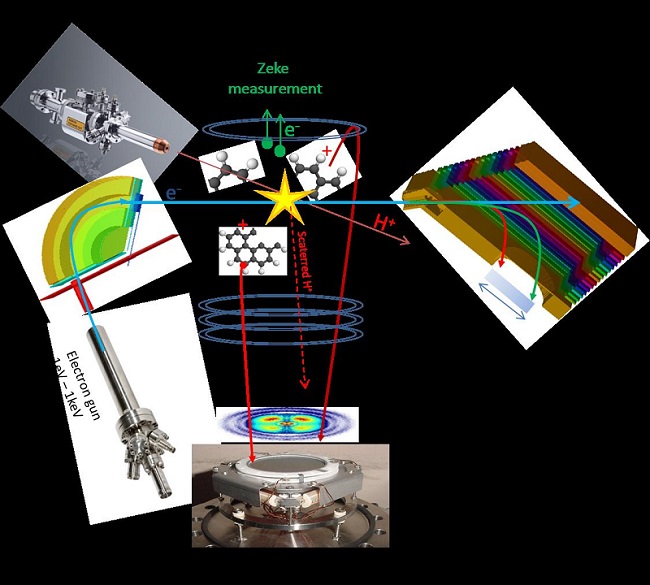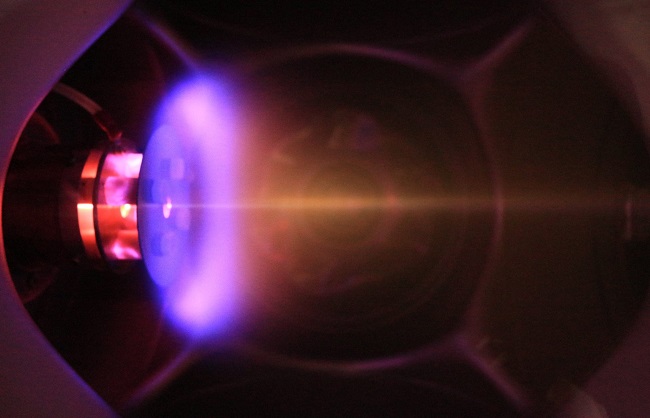Abstract:
The SWEET experiment is the result of a collaboration between three teams from the IRSAMC institute, namely one team from the LCPQ and another from the LPT. It is aimed at the study of molecular dissociation of PAH and prebiotic molecules submitted to stellar wind radiations. Our setup allows precise measurements of the interaction between the particles of the stellar wind and isolated molecules and a follow up of the dissociation dynamic.
Introduction:
When stellar wind particles (protons in the keV energy range or electrons of typically a hundred eVs) interact with isolated molecules, they can trigger their ionization or their fragmentation.
The knowledge of the interactions between the interstellar medium (ISM) molecules, (whether PAH or pre-biotic molecules) and the stellar radiations is therefore essential to understand their lifecycle, their abundance and their role in the complex astro-chemistry of the ISM. Moreover, the small size of these molecules also allows a relatively easy modelization of the energy exchange and ionization processes following the interaction through TDDFT calculations and the comparison of the results obtained within different approximations.
Experimental setup:
Whereas most of the experimental setups give only an incomplete description of the stellar wind/molecule interaction or are focused on UV-molecule photochemistry, our experiment will be able to perform a very comprehensive image of the stellar wind-molecules interaction. The studied molecules are evaporated from an oven in a low density jet. For each single collision event between molecules and projectiles (protons or electrons), we measure the energies involved in the process through energy loss measurements, the masses and 3D velocity vectors of each charged fragment, the electronic emission spectra and the dissociation threshold energies by Zero kinetic energy measurements (ZEKE) of the emitted electrons.
The incident ion or electron energies are tuneable and controlled between 1eV and 1keV and the incident mono-charged ions (H+, He+, C+,N+,O+ …) energy can be varied between 100 eV and 1.5 keV.
Out time-of-flight spectrometer detector is a fast (100ps), multihit, high resolution (50m) two-dimensional readout MCP able to give us the impact points of each charged fragments on the detector and allowing us to determine the velocity vectors of all the charged emitted fragments as well as their masses.
Calculation within the Time-Dependent Density Functional Theory (TDDFT) in real time and real space can then be used to simulate the collisions between a projectile and a molecule. These calculations provide insights on the ionization mechanisms at short time scales, as for example the charge state after the collision enabling us to compare the theoretical simulations against the experimental measurements in a straightforward manner.
For longer time scales quantum chemistry theoretical investigations are performed at LCPQ, using a starting energy surface calculated from state-of-the-art ab-initio approaches such DFT, MP2, CCSD… and allowing the determination of the energy barriers and saddle-points. The fragmentation rates and abundances can be directly obtained from the trajectories.
Grâce à un spectromètre de masse par temps de vol équipé d’une galette à micro-canaux permettant des mesures simultanées, rapides (≈100 ps ) et à haute résolution spatiale (≈50 µm), nous pouvons mesurer pour chaque collision les masses et les vecteurs vitesse de chacun des fragments chargés obtenus, la distribution énergétique des électrons émis et les seuils de dissociation ZEKE (zero kinetic energy measurements)
 schematic diagram of the set up
schematic diagram of the set up




















